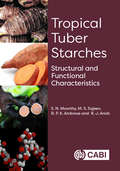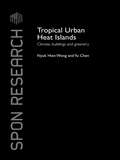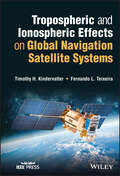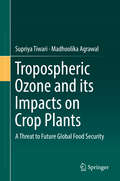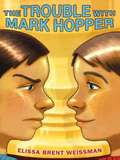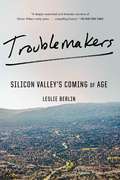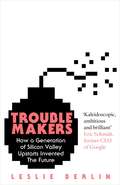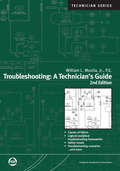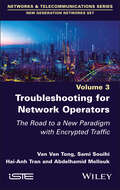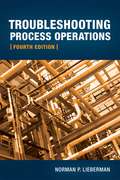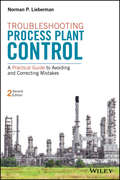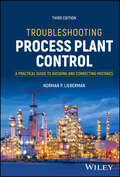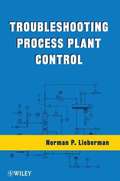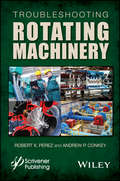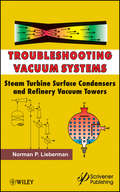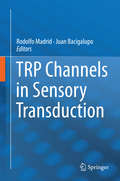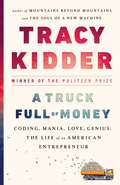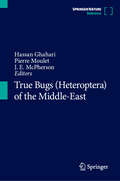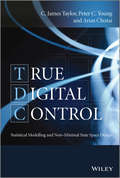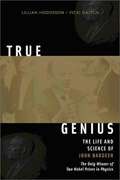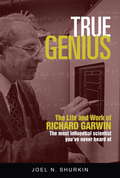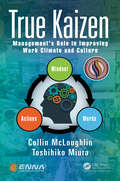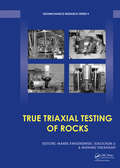- Table View
- List View
Tropical Tuber Starches: Structural and Functional Characteristics
by Dr S N Moorthy Dr M S Sajeev Dr R P Ambrose R J AnishThis book provides comprehensive and up-to-date knowledge relating to the morphological, structural, and functional characteristics of tuber starches, particularly in relation to their applications in food and industry. In recent years there has been significant progress and extensive research conducted on tropical root starches and especially on some of the lesser known tuber crop starches. There has also been a shift towards using biomaterials in place of synthetic materials in various applications. As researchers investigate the availability of natural products with similar properties, starch has been identified as a reliable alternative to these synthetic materials. Reflecting the growing body of research, Tropical Tuber Starches: - Explores the structure, properties and applications of tropical root and tuber starches (cassava, sweet potato, aroids, yams and other minor tuber crops) - Includes a chapter on the methodology for starch characterisation - Covers patents on starch-based products and the commercial potential of tropical root starches A valuable resource for researchers and students, plant breeders, and commercial producers working with, or considering working with, tropical tuber starches.
Tropical Urban Heat Islands: Climate, Buildings and Greenery (Spon Research)
by Nyuk Hien Wong Yu ChenConventional air conditioning is not a sustainable solution to the challenge of a hot or humid climate. The climate problem is compounded in so-called Urban Heat Islands, urban areas where the air can be 3–5°C hotter than its surrounding areas and where pollution levels are consequently raised. Including a colour section with thermal images and maps, this book explores the complex relationships between climate, buildings and plants, especially in urban heat islands. These relationships bear very critically on a range of environmental issues and point to some corresponding solutions. One chapter highlights some of the extensive research work carried out in Singapore, especially investigating the thermal benefits of greenery in buildings in the urban setting. Though several books have been written on urban heat islands, this work uniquely examines the linkages between climate, buildings and plants. It forms a reference for researchers and professionals such as architects, architectural science, landscape architects, building services engineers, urban planners and urban climatologists. It may also be useful for final year undergraduates or graduate students in these disciplines.
Tropospheric and Ionospheric Effects on Global Navigation Satellite Systems
by Timothy H. Kindervatter Fernando L. TeixeiraTropospheric and Ionospheric Effects on Global Navigation Satellite Systems Explore atmospheric effects on radio frequency propagation in the context of Global Navigation Satellite System communication In Tropospheric and Ionospheric Effects on Global Navigation Satellite Systems, a team of distinguished researchers deliver an accessible and authoritative introduction to all scientifically relevant effects caused by the ionosphere and troposphere on GNSS RF signals. The book explores the origin of each type of propagation effect and explains it from a fundamental physical perspective. Each of the major methods used for the measurement, prediction, and mitigation of ionospheric and tropospheric effects on GNSS are discussed in detail. The authors also provide the mechanisms that drive ionization and plasma transport in the ionosphere, propagation phenomena (including scattering, absorption, and scintillations), and the predominant predictive models used to predict ionospheric propagation effects. With an emphasis on global navigation satellite systems, the book discusses the US Standard Atmosphere, a general reference model for characteristics of the unionized atmosphere. It also considers: Thorough introductions to the Global Positioning System and the principles of GNSS positioning Comprehensive explorations of tropospheric propagation and predictive models of the troposphere Practical discussions of the physics of the ionosphere, experimental observation of the ionosphere, and ionospheric propagation In-depth examinations of predictive models of the ionosphere, including group delay models for single-frequency GNSS receivers Ideal for engineers and research scientists with a professional or personal interest in geophysics, RF propagation, and GNSS and GPS applications, Tropospheric and Ionospheric Effects on Global Navigation Satellite Systems will also earn a place in the libraries of undergraduate and graduate students studying RF propagation or GNSS.
Tropospheric Ozone and its Impacts on Crop Plants: A Threat To Future Global Food Security
by Madhoolika Agrawal Supriya TiwariThe research and its outcomes presented here focuses on tropospheric or ground level ozone, in particular due to its surfacing as a major threat to crop productivity around the world. This book presents the ozone concentration data for a variety of geographical regions, examines the factors responsible for its increasing concentrations and its potential effects on physiological and biochemical responses culminating in crop productivity losses which, in turn may pose a serious threat to global food security. Beside this, certain ameliorative measures that could be adopted to assess ozone injury in plants are also discussed.Global climate change scenarios predict a significant increase in future tropospheric ozone concentration. Particular attention is therefore given to evaluate the effect of global climate change on ozone concentrations. Readers will also discover how yield losses due to ozone are related to changes in the socio-economic conditions of the society, especially in South Asian regions. Students and researchers studying crop and soil science, environmental scientists, risk assessment professionals and policy makers will find this book of interest.
The Trouble With Mark Hopper
by Weissman Elissa BrentMark Hopper is the smartest student in the sixth grade, and he knows it. When another Mark Hopper moves to town (the same age, with similar looks), Mark Hopper makes trouble for Mark Hopper. The Mark everyone knows isn't very nice, so the other Mark finds no one will talk to him. The new Mark isn't very brainy, so the other Mark worries that people will think he's a dummy. When a teacher forces them to be study partners, they realize that they can benefit from one another's strengths-and maybe win the Mastermind Challenge together. Trouble is, one of the Marks wants to win so badly that he's willing to steal from Mark.
The Trouble With Mark Hopper
by Elissa Brent WeissmanMark Hopper is the smartest student in the sixth grade, and he knows it. When another Mark Hopper moves to town (the same age, with similar looks), Mark Hopper makes trouble for Mark Hopper. The Mark everyone knows isn't very nice, so the other Mark finds no one will talk to him. The new Mark isn't very brainy, so the other Mark worries that people will think he's a dummy. When a teacher forces them to be study partners, they realize that they can benefit from one another's strengths - and maybe win the Mastermind Challenge together. Trouble is, one of the Marks wants to win so badly that he's willing to steal from Mark.
Troublemakers: Silicon Valley's Coming of Age
by Leslie BerlinThe richly told narrative of the Silicon Valley generation that launched five major high-tech industries in seven years, laying the foundation for today’s technology-driven world.At a time when the five most valuable companies on the planet are high-tech firms and nearly half of Americans say they cannot live without their cell phones, Troublemakers reveals the untold story of how we got here. This is the gripping tale of seven exceptional men and women, pioneers of Silicon Valley in the 1970s and early 1980s. Together, they worked across generations, industries, and companies to bring technology from Pentagon offices and university laboratories to the rest of us. In doing so, they changed the world. In Troublemakers, historian Leslie Berlin introduces the people and stories behind the birth of the Internet and the microprocessor, as well as Apple, Atari, Genentech, Xerox PARC, ROLM, ASK, and the iconic venture capital firms Sequoia Capital and Kleiner Perkins Caufield & Byers. In the space of only seven years and thirty-five miles, five major industries—personal computing, video games, biotechnology, modern venture capital, and advanced semiconductor logic—were born. During these same years, the first ARPANET transmission came into a Stanford lab, the university began licensing faculty innovations to businesses, and the Silicon Valley tech community began mobilizing to develop the lobbying clout and influence that have become critical components of modern American politics. In other words, these were the years when one of the most powerful pillars of our modern innovation and political systems was first erected. Featured among well-known Silicon Valley innovators like Steve Jobs, Regis McKenna, Larry Ellison, and Don Valentine are Mike Markkula, the underappreciated chairman of Apple who owned one-third of the company; Bob Taylor, who kick-started the Arpanet and masterminded the personal computer; software entrepreneur Sandra Kurtzig, the first woman to take a technology company public; Bob Swanson, the cofounder of Genentech; Al Alcorn, the Atari engineer behind the first wildly successful video game; Fawn Alvarez, who rose from an assembler on a factory line to the executive suite; and Niels Reimers, the Stanford administrator who changed how university innovations reach the public. Together, these troublemakers rewrote the rules and invented the future.
Troublemakers: How a Generation of Silicon Valley Upstarts Invented the Future
by Leslie Berlin**THE FINANCIAL TIMES BUSINESS BOOK OF THE MONTH** THE GRIPPING TALE OF THE EARLY FRONTIER DAYS OF SILICON VALLEY FROM ACCLAIMED HISTORIAN LESLIE BERLIN. 'The book is compelling as it maps out the building of the Valley, the challenges its early tech pioneers faced, as well as highlighting those who reached dizzying success only to suffer as the dot com bubble burst.' Financial Times ‘Kaleidoscopic, ambitious, and brilliant, the book draws on a dazzling cast of characters to chart the rise of the five industries that have come to define technology today and, collectively, to remake the world.’ Eric Schmidt, former CEO of Google and Executive Chairman of Alphabet, Inc.Leslie Berlin's previous work has been acclaimed by the New York Times: 'so engagingly narrated that you don't realize how much business and technology you are learning along the way.' Between 1968 and 1976, five landmark industries that shaped the modern world were launched within 30 miles of each other: personal computing, video games, biotechnology, modern venture capital and advanced semi-conductor logic. The dominant players in many of those industries - firms like Apple and Intel - had also been launched at the same time. During those early days of Silicon Valley, the first ARPANET transmission (now known as the Internet) came into a Stanford lab, universities began licensing innovations to businesses, and the Silicon Valley tech community began to develop their lobbying clout. Now, for the first time, the stories of the men and women who changed the world during these pivotal years are brought to life in rich detail by respected Silicon Valley historian Leslie Berlin. Berlin shines a light on the wild frontier days of Silicon Valley where the old rules were broken, revealing how the modern tech world was built and empires were forged. Troublemakers is a compelling story of the upstarts of Silicon Valley that will appeal to fans of HBO's Silicon Valley and Walter Isaacson's biography of Steve Jobs. Further praise for Troublemakers: ‘Leslie Berlin combines the keen observations of an historian with gorgeous writing and riveting storytelling to write the landmark book on the Valley. The interwoven lives of wonderfully iconoclastic characters bring the formative years of the Valley to life with sheer brilliance. Troublemakers is a must-read for anyone hoping to understand America’s tech capital.’Julia Flynn Siler, New York Times bestselling author of The House of Mondavi ‘Leslie Berlin has done it again. Following on her richly informative biography of Intel co-founder Robert Noyce, The Man Behind the Microchip, Berlin now brings us a definitive account of Silicon Valley’s “breakthrough years” in the 1970s. Troublemakers recounts the fascinating careers of seven little-known but enormously impactful players who shaped the Valley’s unique high-tech ecosystem. As entertaining as it is authoritative, Troublemakers is required reading for anyone seeking to understand how the tech revolution took root in the San Francisco Bay Area and eventually transformed the entire planet’s way of life.’David M. Kennedy, Donald J. McLachlan Professor of History Emeritus at Stanford University, winner of the Pulitzer Prize
Troubleshooting: A Technician's Guide
by William L. Mostia Jr.Troubleshooting loops and systems is something all technicians must do, but that few truly master. This edition draws on the author's long experience as an instrument and electrical engineer and his maintenance expertise to provide a detailed look at the skills and knowledge required for troubleshooting. Interspersed with a wealth of practical detail and real-world examples are Mostia's no-nonsense discussions of what a good troubleshooter needs to know. He provides an in-depth discussion of the basic logical framework that underlies all troubleshooting as well as advanced troubleshooting techniques. He also explores the causes of failures and the techniques that engineers and technicians use to trace them down. This edition covers troubleshooting methods, both basic and advanced, hints and troubleshooting aids, troubleshooting safety, basic maintenance concepts, information about training, and the developing troubleshooting skills. It also includes numerous examples of troubleshooting problems in mechanical systems, process connections, pneumatic systems, electrical systems, electronic systems, and valves. Mostia also explores test equipment, programmable electronic systems, communication circuits, transient problems, and software. - See more at: https://www.isa.org/store/products/product-detail/?productId=116195#sthash.CjIr9eVF.dpuf
Troubleshooting Finite-Element Modeling with Abaqus: With Application in Structural Engineering Analysis
by Raphael Jean BoulbesThis book gives Abaqus users who make use of finite-element models in academic or practitioner-based research the in-depth program knowledge that allows them to debug a structural analysis model. The book provides many methods and guidelines for different analysis types and modes, that will help readers to solve problems that can arise with Abaqus if a structural model fails to converge to a solution. The use of Abaqus affords a general checklist approach to debugging analysis models, which can also be applied to structural analysis.The author uses step-by-step methods and detailed explanations of special features in order to identify the solutions to a variety of problems with finite-element models. The book promotes: • a diagnostic mode of thinking concerning error messages; • better material definition and the writing of user material subroutines; • work with the Abaqus mesher and best practice in doing so; • the writing of user element subroutines and contact features with convergence issues; and• consideration of hardware and software issues and a Windows HPC cluster solution.The methods and information provided facilitate job diagnostics and help to obtain converged solutions for finite-element models regarding structural component assemblies in static or dynamic analysis. The troubleshooting advice ensures that these solutions are both high-quality and cost-effective according to practical experience. The book offers an in-depth guide for students learning about Abaqus, as each problem and solution are complemented by examples and straightforward explanations. It is also useful for academics and structural engineers wishing to debug Abaqus models on the basis of error and warning messages that arise during finite-element modelling processing.
Troubleshooting for Network Operators: The Road to a New Paradigm with Encrypted Traffic
by Van Van Tong Sami Souihi Hai-Anh Tran Abdelhamid MelloukNowadays, the Internet is becoming more and more complex due to an everincreasing number of network devices, various multimedia services and a prevalence of encrypted traffic. Therefore, in this context, this book presents a novel efficient multi modular troubleshooting architecture to overcome limitations related to encrypted traffic and high time complexity. This architecture contains five main modules: data collection, anomaly detection, temporary remediation, root cause analysis and definitive remediation. In data collection, there are two sub modules: parameter measurement and traffic classification. This architecture is implemented and validated in a software-defined networking (SDN) environment.
Troubleshooting Process Operations
by Norman LiebermanDrawing on his passion, training, and experience, Lieberman presents problems and troubleshooting techniques that are associated with specific processes, systems, and equipment, leading novice and practiced troubleshooters alike to the crux of malfunctions and failures. The fourth edition updates troubleshooting and design techniques, and adds seven new chapters with information on turbines, motors, heat exchangers, and environmentally friendly operations. Norm Lieberman sprinkles his troubleshooting guide with insightful and humorous anecdotes from 45 years in the petrochemical and refining industry. Features: * Nitty-gritty descriptions of common refinery and chemical plant problems and the diagnostic field observations, experiments, and calculations that reveal their origin * Troubleshooting checklists and references following each chapter * Practical advice for optimizing interactions with key plant operations personnel
Troubleshooting Process Plant Control: A Practical Guide to Avoiding and Correcting Mistakes
by Norman P. LiebermanExamines real life problems and solutions for operators and engineers running process controls Expands on the first book with the addition of five new chapters as well as new troubleshooting examples Written for the working operator and engineer, with straightforward instruction not hinged on complex math Includes real-life examples of control problems that commonly arise and how to fix them Emphasizes single and well-established process engineering principles that will help working engineers and operators switch manual control loops to automatic control
Troubleshooting Process Plant Control: A Practical Guide to Avoiding and Correcting Mistakes
by Norman P. LiebermanA practical and engaging guide to running process controls in petrochemical plants and refineries Process control is an area of study dealing with controlling variables that emerge in process plants, such as chemical plants, wastewater purification plants, or refineries. Existing guides to process control are numerous, but they tend to be associated with control engineering, which is more mathematical and theoretical. There is an urgent need for a more straightforward and concrete guide for practical use in petrochemical plants and refineries. Troubleshooting Process Plant Control meets this need with a work dedicated to real-life solutions and problem solving. Rooted in real-world examples and the career experience of the author, it largely avoids complex mathematics in favor of practical, well-established process engineering principles. Now fully updated to reflect the latest best practices and developments in the field, it is indispensable for process controllers in active plants of all kinds. Readers of the third edition will also find: New chapters on alarm disabling, spectrometer use, and reducing CO2 emissionsAdditional novel examples throughoutGuidelines for using spectrometers to directly control reflux rates and steam flow to reboilers Troubleshooting Process Plant Control is ideal for practicing engineers and other technical professionals working in process facilities, as well as advanced students taking professional training courses in these fields.
Troubleshooting Process Plant Control
by Norman P. LiebermanThe book focuses on process control in the petroleum and refinery industries, with an emphasis on problem solving. The author explores various real life examples and relays the lessons learned from his career in this area. He explains many new yet straightforward concepts without the use of complex mathematics. This handy go-to emphasizes single and well-established process engineering principles that will help working engineers and operators switch manual control loops to automatic control.
Troubleshooting Rotating Machinery: Including Centrifugal Pumps and Compressors, Reciprocating Pumps and Compressors, Fans, Steam Turbines, Electric Motors, and More
by Robert X. Perez Andrew P. ConkeyProcess machines are critical to the profitability of processes. Safe, efficient and reliable machines are required to maintain dependable manufacturing processes that can create saleable, on-spec product on time, and at the desired production rate. As the wards of process machinery, we wish to keep our equipment in serviceable condition. One of the most challenging aspects of a machinery professional or operator's job is deciding whether an operating machine should be shut down due to a perceived problem or be allowed to keep operating. If he or she wrongly recommends a repair be conducted, the remaining useful machine life is wasted, but if he or she is right, they can save the organization from severe consequences, such as product releases, fires, costly secondary machine damage, etc. This economic balancing act is at the heart of all machinery assessments. Troubleshooting is part science and part art. Simple troubleshooting tables or decision trees are rarely effective in solving complex, real-world machine problems. For this reason, the authors want to offer a novel way to attack machinery issues that can adversely affect the reliability and efficiency of your plant processes. The methodology presented in this book is not a rigid "cook book" approach but rather a flexible and dynamic process aimed at exploring process plant machines holistically, in order uncover the true nature the problem at hand.
Troubleshooting Vacuum Systems
by Norman P. LiebermanVacuum systems are in wide spread use in the petrochemical plants, petroleum refineries and power generation plants. <P><P>The existing texts on this subject are theoretical in nature and only deal with how the equipment functions when in good mechanical conditions, from the viewpoint of the equipment vendor. In this much-anticipated volume, one of the most well-respected and prolific process engineers in the world takes on troubleshooting vacuum systems, and especially steam ejectors, an extremely complex and difficult subject that greatly effects the profitability of the majority of the world's refineries.
TRP Channels in Sensory Transduction
by Rodolfo Madrid Juan BacigalupoTRP channels play a key role in sensory physiology and have been the focus of intensive investigation in recent years. The proposed book will be a comprehensive, detailed overview of the ways in which TRP channels are involved in a wide variety of sensory modalities. Authors will explore the involvement of TRP channels in photo transduction (sight), chemotransduction (taste and odor), mechanotransduction (touch and hearing), thermo transduction (the sensation of temperature) and pain perception. Furthermore, the book will include some grounding chapters such as one on the history of TRP channel research, one on the biophysical characteristics of the proteins and one on trafficking and post-translational regulation.
A Truck Full of Money: One Man's Quest to Recover from Great Success
by Tracy Kidder"A perfectly executed, exquisitely reported parable of the Internet age and the wild, mad adventure that is start-up culture."--Charles Duhigg Fortune, mania, genius, philanthropy--the bestselling author of Mountains Beyond Mountains gives us the inspiring story of Paul English, the founder of Kayak.com and Lola. Tracy Kidder, the "master of the nonfiction narrative" (The Baltimore Sun) and author of the bestselling classic The Soul of a New Machine, now tells the story of Paul English, a kinetic and unconventional inventor and entrepreneur, who as a boy rebelled against authority. Growing up in working-class Boston, English discovers a medium for his talents the first time he sees a computer. As a young man, despite suffering from what would eventually be diagnosed as bipolar disorder, he begins his pilgrim's journey through the ups and downs in the brave new world of computers. Relating to the Internet as if it's an extension of his own mind, he discovers that he has a talent for conceiving innovative enterprises and building teams that can develop them, becoming "a Pied Piper" of geeks. His innovative management style, success, and innate sense of fair play inspire intense loyalty. Early on, one colleague observes: "Someday this boy's going to get hit by a truck full of money, and I'm going to be standing beside him." Yet when English does indeed make a fortune, when the travel website Kayak is sold for almost two billion dollars--the first thing he thinks about is how to give the money away: "What else would you do with it?" The second thing he thinks is, What's next? With the power of a consummate storyteller, Tracy Kidder casts a fresh, critical, and often humorous eye on the way new ideas and new money are reshaping our culture and the world. A Truck Full of Money is a mesmerizing portrait of an irresistibly endearing man who is indefatigable, original, and as unpredictable as America itself. Advance praise for A Truck Full of Money"A perfectly executed, exquisitely reported parable of the Internet age, and the wild, mad adventure that is start-up culture."--Charles Duhigg "A Truck Full of Money brings us into unknown spaces of the complex workings of the mind--of a brilliant software engineer, of this new decade, of the brutal/fast business of technology, of stunning privilege, and of one man's efforts to put his fortune to humane use."--Adrian Nicole LeBlanc"The story of [an] entrepreneur's remarkable life [and] the new American economy and the technological world that built it. More engrossing work from a gifted practitioner of narrative nonfiction."--Kirkus ReviewsFrom the Hardcover edition.
True Bugs (Heteroptera) of the Middle-East
by Hassan Ghahari Pierre Moulet J. E. McPhersonThis reference guide covers information on the true bugs (Heteroptera) of Middle East and includes taxonomy, general biology, economic importance, applied aspects, and distributional data. It also includes up-to-date reviews of the literature on the Heteroptera of the Middle East. The book represents a clear guide for future research in heteropteran biology. Apart from providing a taxonomic treatment of all the families known from the Middle East, information is provided on Iranian and general geographic distributions, bionomics, ecology, natural enemies, prey records, and plant associations for the various species. General discussion also is included on morphology, economic importance, family characters of each group, and affinity with related groups. This book includes detailed information on more than 2,000 species of the Middle East Heteroptera belonging to 58 families. An exhaustive bibliography (over 4,000) has been provided to facilitate studies of chosen aspects of the various species. Up-to-date information for the various species has been provided as far as possible. The book contains the contributions of 37 heteropteran specialists from 17 countries. This book is of interest to teachers, researchers, and masters and Ph. D students of entomology, biosciences, agriculture, biological control, IPM (Integrated Pest Management), and environmental sciences. Also, the book serves as additional reading material for undergraduate and graduate students of the mentioned scientific fields. National and international entomological and agricultural scientists may also find the book to be a useful read as well as those individuals who are active in medical, urban, and forensic entomology because there are several heteropteran pests in these fields.
True Digital Control: Statistical Modelling and Non-Minimal State Space Design
by C. James Taylor Peter C. Young Arun ChotaiTrue Digital Control: Statistical Modelling and Non–Minimal State Space Designdevelops a true digital control design philosophy that encompasses data–based model identification, through to control algorithm design, robustness evaluation and implementation. With a heritage from both classical and modern control system synthesis, this book is supported by detailed practical examples based on the authors’ research into environmental, mechatronic and robotic systems. Treatment of both statistical modelling and control design under one cover is unusual and highlights the important connections between these disciplines. Starting from the ubiquitous proportional–integral controller, and with essential concepts such as pole assignment introduced using straightforward algebra and block diagrams, this book addresses the needs of those students, researchers and engineers, who would like to advance their knowledge of control theory and practice into the state space domain; and academics who are interested to learn more about non–minimal state variable feedback control systems. Such non–minimal state feedback is utilised as a unifying framework for generalised digital control system design. This approach provides a gentle learning curve, from which potentially difficult topics, such as optimal, stochastic and multivariable control, can be introduced and assimilated in an interesting and straightforward manner. Key features: Covers both system identification and control system design in a unified manner Includes practical design case studies and simulation examples Considers recent research into time–variable and state–dependent parameter modelling and control, essential elements of adaptive and nonlinear control system design, and the delta–operator (the discrete–time equivalent of the differential operator) systems Accompanied by a website hosting MATLAB examples True Digital Control: Statistical Modelling and Non–Minimal State Space Design is a comprehensive and practical guide for students and professionals who wish to further their knowledge in the areas of modern control and system identification.
True Genius: The Life And Science Of John Bardeen
by Lillian Hoddeson Vicki DaitchWhat is genius? Define it. Now think of scientists who embody the concept of genius. Does the name John Bardeen spring to mind? Indeed, have you ever heard of him?Like so much in modern life, immediate name recognition often rests on a cult of personality. We know Einstein, for example, not just for his tremendous contributions to science, but also because he was a character, who loved to mug for the camera. And our continuing fascination with Richard Feynman is not exclusively based on his body of work; it is in large measure tied to his flamboyant nature and offbeat sense of humor.These men, and their outsize personalities, have come to erroneously symbolize the true nature of genius and creativity. We picture them born brilliant, instantly larger than life. But is that an accurate picture of genius? What of others who are equal in stature to these icons of science, but whom history has awarded only a nod because they did not readily engage the public? Could a person qualify as a bona fide genius if he was a regular Joe?The answer may rest in the story of John Bardeen.John Bardeen was the first person to have been awarded two Nobel Prizes in the same field. He shared one with William Shockley and Walter Brattain for the invention of the transistor. But it was the charismatic Shockley who garnered all the attention, primarily for his Hollywood ways and notorious views on race and intelligence.Bardeen’s second Nobel Prize was awarded for the development of a theory of superconductivity, a feat that had eluded the best efforts of leading theorists—including Albert Einstein, Neils Bohr, Werner Heisenberg, and Richard Feynman. Arguably, Bardeen’s work changed the world in more ways than that of any other scientific genius of his time. Yet while every school child knows of Einstein, few people have heard of John Bardeen. Why is this the case?Perhaps because Bardeen differs radically from the popular stereotype of genius. He was a modest, mumbling Midwesterner, an ordinary person who worked hard and had a knack for physics and mathematics. He liked to picnic with his family, collaborate quietly with colleagues, or play a round of golf. None of that was newsworthy, so the media, and consequently the public, ignored him.John Bardeen simply fits a new profile of genius. Through an exploration of his science as well as his life, a fresh and thoroughly engaging portrait of genius and the nature of creativity emerges. This perspective will have readers looking anew at what it truly means to be a genius.
True Genius: The Life and Work of Richard Garwin, the Most Influential Scientist You've Never Heard of
by Joel ShurkinRichard Garwin was awarded the Presidential Medal of Freedom by President Barack Obama Called a "true genius" by Enrico Fermi, Richard Garwin has influenced modern life in far-reaching ways, yet he is hardly known outside the physics community. This is the first biography of one of America's great minds--a top physicist, a brilliant technological innovator, and a trusted advisor of presidents for sixty years. Among his many contributions to modern technology are innovations we now take for granted: air-traffic control systems, touch screens, color monitors, laser printers, GPS satellite navigation, and many other facets of everyday contemporary life.But certainly his most important work has been on behalf of nuclear disarmament. As a key member of the Los Alamos team that developed the hydrogen bomb (he created the final design), Garwin subsequently devoted much of his career to ensuring that nuclear weapons never again be used. He has spent hundreds of hours testifying before Congress, serving on government advisory committees, and doing work that is still classified, all the while working for IBM as a researcher. A genuine polymath, his ideas extend from propulsion systems for interplanetary flight to preventing flu epidemics. Never shy about offering his opinions, even to rigid government bureaucracies unwilling to change, Garwin continues to show leaders how to do the smart thing. The world is a more interesting and safer place because of his many accomplishments.
True Kaizen: Management's Role in Improving Work Climate and Culture
by Collin McLoughlin Toshihiko MiuraWhat does it take to manage an organization to success? No matter what industry you are in, an organization is primarily a group of people. This book focuses on that ever-important human element. In the rush to get 'lean', many organizations focus solely on tools for increasing productivity, but where do these tools come from? In this book, Collin McLoughlin and Toshihiko Miura look back on their decades of international consulting experience to examine how organizations around the world have transformed on a cultural level by respecting the people who work within them and leveraging their creativity to solve problems. As our workforce becomes more knowledgeable, skillful, and more perceptive of their needs and wants as employees, the ability to reach the true potential of an organization becomes more and more difficult. Managers must look at each individual element of an equation like this in order to fully understand how to achieve an answer. They must begin to answer more focused questions, such as: 1. How productive is the existing work climate and culture? 2. How do employees, as individuals, navigate the existing work climate? (How do they deal with day-today issues with each other?) 3. Where and how are individuals and their work processes assessed? 4. What obstacles do employees face every day, and are they empowered to fix these obstacles? 5. What role does leadership play at each level of the organization? (Looking at the organization in layers of management.) To address these challenges, this book focuses on three main aspects of leadership and management: 1. Addressing and Improving the Perspective of Management -- The ideas presented in this book are not limited to a certain industry or field of work, but can be applied in any setting because they speak to a universal human element. 2. Exploring and Improving Work Climate -- Organizations are social entities, operating within their own controlled environment. This book will explore the factors that contribute to, and encourage, a positive work climate. 3. Observing and Eliminating Wasteful Work Processes -- Observing wasteful activities and work processes requires a refined perspective. The case studies presented illustrate the How and Why to help refine expertise. This will also lead to the joy and benefits
True Triaxial Testing of Rocks (Geomechanics Research Series #4)
by Xiaochun Li Marek Kwaśniewski Manabu TakahashiThe book provides a guide to rock engineers and engineering geologists as to how to perform laboratory tests and how to use the existing data for solving practical rock engineering design and operating problems. Knowledge of the behavior of rocks under general triaxial compression is also of crucial importance in the fields of structural geology and tectonophysics as the effect of the intermediate and the minimum principal stresses may be a decisive factor in the mode of deformation and processes of gross-fracturing, faulting and earthquakes.
